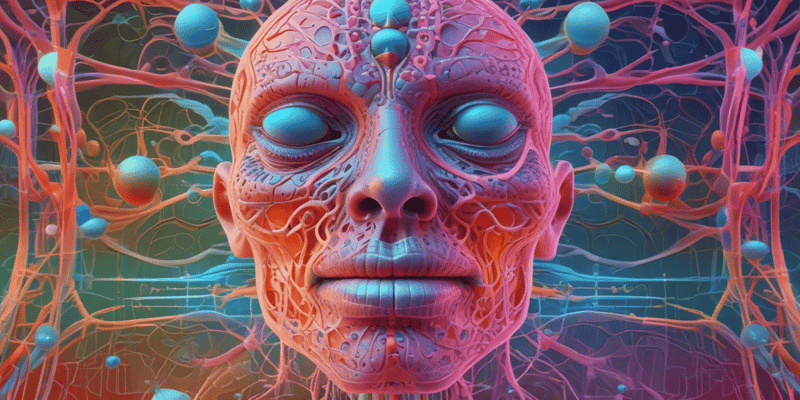Podcast
Questions and Answers
What is the primary function of osmoregulation in the body?
What is the primary function of osmoregulation in the body?
What is the role of feedback mechanisms in homeostasis?
What is the role of feedback mechanisms in homeostasis?
Which system is responsible for ensuring an adequate oxygen supply to the body?
Which system is responsible for ensuring an adequate oxygen supply to the body?
Which of the following is NOT a result of the disruption of homeostatic mechanisms?
Which of the following is NOT a result of the disruption of homeostatic mechanisms?
Signup and view all the answers
What is the primary function of the kidneys in osmoregulation?
What is the primary function of the kidneys in osmoregulation?
Signup and view all the answers
Which hormone helps to maintain blood sugar levels within a narrow range?
Which hormone helps to maintain blood sugar levels within a narrow range?
Signup and view all the answers
Which physiological parameter is NOT typically regulated as part of homeostasis?
Which physiological parameter is NOT typically regulated as part of homeostasis?
Signup and view all the answers
What mechanism do ectothermic animals use to regulate their body temperature?
What mechanism do ectothermic animals use to regulate their body temperature?
Signup and view all the answers
Which hormone promotes the uptake of glucose by cells and its conversion to glycogen for storage?
Which hormone promotes the uptake of glucose by cells and its conversion to glycogen for storage?
Signup and view all the answers
What is the role of feedback mechanisms in homeostasis?
What is the role of feedback mechanisms in homeostasis?
Signup and view all the answers
Which system does NOT employ homeostatic regulation?
Which system does NOT employ homeostatic regulation?
Signup and view all the answers
Which process is involved in the regulation of body temperature in endothermic animals?
Which process is involved in the regulation of body temperature in endothermic animals?
Signup and view all the answers
Study Notes
Homeostasis: Maintaining Equilibrium
Homeostasis is the process by which the body maintains a stable internal environment, despite fluctuations in external conditions. It involves the regulation of various physiological parameters, such as body temperature, blood sugar, and osmotic pressure, among others. Homeostasis is facilitated through feedback mechanisms that enable the body to respond to changes in these parameters and adjust accordingly to maintain equilibrium.
Regulation of Body Temperature
The regulation of body temperature, also known as thermoregulation, is a critical aspect of homeostasis. Endothermic animals (mammals and birds) maintain their body temperature through a complex system involving vasodilation and vasoconstriction, which allows them to dissipate or conserve heat as needed. Ectothermic animals (reptiles, insects, and fish) rely on behavioral adaptations to regulate their body temperature, such as seeking shade or warmer areas depending on their environment.
Blood Sugar Regulation
The body maintains a constant level of blood sugar (glucose) through a balance between insulin and glucagon, which work in opposition to each other. Insulin, produced by beta cells in the pancreas, promotes the uptake of glucose by cells and its conversion to glycogen for storage, while glucagon, produced by alpha cells, stimulates the release of glucose from the liver and its transfer to the bloodstream.
Osmoregulation
Osmoregulation involves the maintenance of the body's water balance, which is crucial for its overall functioning. The kidneys play a key role in this process, regulating the concentration of solutes in the body and adjusting water intake as needed.
Role of Feedback Mechanisms
Feedback mechanisms are essential for maintaining homeostasis by allowing the body to detect changes in physiological parameters and respond accordingly to correct these changes. In blood sugar regulation, for example, insulin and glucagon work in a feedback loop to maintain blood sugar levels within a narrow range.
Homeostasis in Various Systems
Homeostasis is not limited to the regulation of body temperature, blood sugar, and osmotic pressure. It also extends to other systems, such as the cardiovascular system, respiratory system, and immune system, among others. For instance, the cardiovascular system is involved in maintaining blood pressure, while the respiratory system ensures an adequate oxygen supply to the body.
In conclusion, homeostasis is a vital process that enables the body to maintain a stable internal environment in the face of external changes. It involves the regulation of various physiological parameters, such as body temperature, blood sugar, osmotic pressure, and blood pressure, among others. Feedback mechanisms play a crucial role in this process, allowing the body to detect changes and respond accordingly to maintain equilibrium. The disruption of homeostatic mechanisms can lead to various health issues, including diabetes, hypoglycemia, and hyperthermia, among others.
Studying That Suits You
Use AI to generate personalized quizzes and flashcards to suit your learning preferences.
Description
Test your knowledge on homeostasis, body temperature regulation, blood sugar regulation, osmoregulation, and feedback mechanisms in maintaining equilibrium within the body. Explore how different systems, such as the cardiovascular and respiratory systems, contribute to overall homeostasis.




